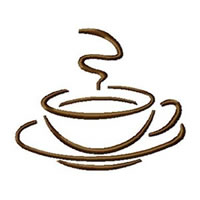All display the wine- and fruit-toned acidity characteristic of Africa and Arabia coffees, but Ethiopias play a rich range of variations on this theme. These variations are in part determined by processing method. Ethiopia coffees neatly divide into those processed by the dry method (the beans are dried inside the fruit) and those processed by sophisticated, large-scale wet method, in which the fruit is immediately removed from the beans in a series of complex operations before the beans are dried.
Ethiopia Casual Dry-Processed Coffees. In most parts of Ethiopia dry-processing is a sort of informal, fall-back practice used to process small batches of coffee for local consumption. Everywhere that even a single coffee tree grows, someone will pick the fruit and put it out to dry. I recall driving along a seemingly uninhabited road in western Ethiopia and suddenly coming upon a slice of pavement that had been walled off with a row of rocks to protect a patch of drying coffee! Such informally dry-processed coffee is seldom exported, but simply hulled, roasted and drunk on the spot or sold into the local market.
Instead, the best and ripest coffee fruit is sold to wet processing mills, called washing stations, where it is prepared for export following the most up-to-date methods. Only the left-overs, the unripe and overripe fruit is put out to dry, usually not on roads, but on raised, table-like mats in front of the farmers’ clay and thatched houses. This dry-processed coffee may reach export markets, but only as filler coffees for inexpensive blends.
Ethiopia Dry-Processed Harrar. The exception to dry-processed coffee’s second-class status in Ethiopia is the celebrated and often superb coffee of Harrar, the predominantly Muslim province to the east of the capital of Addis Ababa. In Harrar, all coffee fruit, including the best and ripest, is put out in the sun to dry, fruit and all. Often, the fruit is allowed to dry directly on the tree. The result is a coffee much like Yemen, wild, fruity, complexly sweet, with a slightly fermented aftertaste. This flavor profile, shared by both Yemens and Ethiopia Harrars, is often called the Mocha taste, and is one of the great and distinctive experiences of the coffee world. For this reason Harrar often is sold as Mocha or Moka, adding to the confusion surrounding that abused term. Some retailers cover both bases by calling the Ethiopian version of this coffee type Moka Harrar. Harrar may be spelling Harari, Harer, or Harar.
Yirgacheffe and Other Wet-Processed Ethiopias. The first wet-processing mills were established in Ethiopia in 1972, and three decades later more and more coffees in the south and west of Ethiopia are being processed using a sophisticated version of the wet method. The immediate removal of fruit involved in wet-processing apparently softens the fruity, wine-like profile of dried-in-the-fruit coffees like Harrars and turns it gentle, round, delicately complex, and fragrant with floral innuendo.
In the wet-processed coffees of the Yirgacheffe region, a lush, deep-soiled region of high rolling hills in southwestern Ethiopia, this profile reaches a sort of extravagant, almost perfumed apotheosis. Ethiopia Yirgacheffe, high-toned and alive with shimmering citrus and flower tones, may be the world’s most distinctive coffee. Other Ethiopia wet-processed coffees — Washed Limu, Washed Sidamo, Washed Jima, and others — are typically soft, round, floral and citrusy, but less explosively fragrant than Yirgacheffe. They can be very fine and distinctive coffees, however.
Most Ethiopia coffees are grown without use of agricultural chemicals in the most benign of conditions: under shade and interplanted with other crops. The only exceptions are a handful of wet-processed coffees produced by large, government-run estates in southwestern Ethiopia that make discreet use of chemicals. Harrars and Yirgacheffes in particular are what Ethiopians call "garden coffees," grown on small plots by villagers using completely traditional methods.
Geographic Origins > Coffees from Africa and Arabia :
Burundi - Ethiopia - Kenya - Uganda - Tanzania - Malawi - Yemen - Zambia - Zimbabwe
